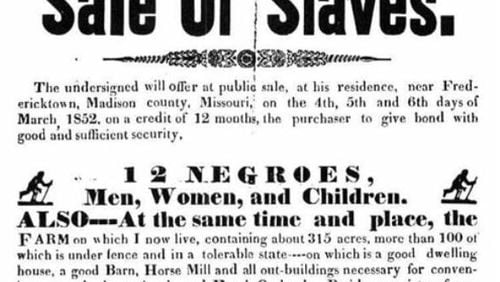Most people understand that teaching slavery, the Holocaust or genocide should never entail a lesson plan that includes the word "game."
But it's still apparently hard for schools to figure out how to get these emotionally charged, but vitally important lessons right, as reflected in a WSB TV report today on a slavery question posed in a seventh grade social studies class in Duluth.
The students were asked to respond to the following: "Slavery wasn't such a bad thing because slaves were an important investment and people take care of important investments. Explain why you agree or disagree."
"I really didn't feel comfortable writing," student Lyndon Nichols said. "What bothered me most is that they said it wasn't that bad."
Lyndon went home and told his mother about the assignment. "Right now, I'm still haunted by it, that he saw something like that," Angela Nichols said. "Slavery is like sex. That's a touchy subject. You have to notify parents about that."
The principal apologized to the student and his mother, removed the question and exercise from the lesson plan and has worked with the family to address their concerns. Lyndon has been moved to another class.
The district issued a statement about the lesson:
While the study of Africa and slavery are part of the 7th grade curriculum, this particular activity did not come from our social studies office. When the administration at Coleman Middle learned that a student felt uncomfortable with one of the statements that was a part of the activity, the principal looked into the student's concerns and understood how the statement could have been taken out of context. The principal then apologized to the student and his mother, removed the question and exercise from the lesson plan, and has worked with the family to address their concerns.
Slavery is a major and influential part of U.S. history and, of course, must be taught. The question at Coleman Middle tried to get students thinking about moral issues and assumptions. Could the complex issues been raised in a less clumsy manner but still prodded students to think about the implications of viewing human beings as commodities?
A report released this week offers valuable assistance with such questions. The Southern Poverty Law Center's new report reveals how little U.S. students understand about slavery and its role in America. Among the findings of "Teaching Hard History: American Slavery":
Two-thirds (68 percent) don't know that it took a constitutional amendment to formally end slavery.
Fewer than 1 in 4 students (22 percent) can correctly identify how provisions in the Constitution gave advantages to slaveholders.
The study notes slavery isn't in the past; it's in the headlines:
A fifth-grader is "sold" at a mock slave auction in a New Jersey school. On a day when Georgia students are encouraged to dress in Civil War-era costumes, a white student dressed as a plantation owner tells a 10-year-old black student, "You are my slave." A California teacher stages a classroom simulation of conditions on a slaver's ship to provide a "unique learning experience." A fourth-grader checks with his mother when his English homework asks him to "give three 'good' reasons for slavery." Scholastic, the largest publisher of children's books, recalls a picture book because of its portrayal of enslaved people as happy and eager to please their enslavers. A popular textbook refers to forcibly imported Africans as "workers." Secretary of Housing and Urban Development Ben Carson refers to the abducted and enslaved as "immigrants." Meanwhile, Georgetown University reveals that it achieved early financial security through the sale of nearly 300 enslaved people and promises preferential admission to their descendants, and Yale University renames a residential college previously named after a notorious enslaver.
The report surveyed more than 1,700 social studies teachers across the country. Most expressed dissatisfaction with the resources they have for teaching slavery.
The problem goes beyond poor materials. The subject matter is difficult. We cannot discuss this fundamental part of American history without talking about racism and racialized violence, including sexual violence. When we talk about slavery, we are talking about hundreds of years of institutionalized violence against millions of people. Teachers—like most Americans—struggle to have open and honest conversations about race. How do they talk about slavery's legacy of racial violence in their classrooms without making their black students feel singled out? How do they discuss it without engendering feelings of guilt, anger or defensiveness among their white students? This unease is particularly acute for white teachers, who make up the overwhelming majority (82 percent) of the U.S. teaching workforce.They want to teach an unsanitized version of American history, but they don't want to heap negative stories on black students. Making things worse, an increasing number of teachers work in highly segregated classrooms. They face additional challenges. What happens if students come into conflict with each other? What if classroom instruction triggers racial animus? How will such lessons affect children's sense of self-worth? These kinds of concerns dissuade teachers from confronting big questions and essential history with their students.
Teachers can access free resources on teaching American slavery here.
About the Author







